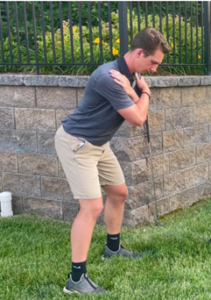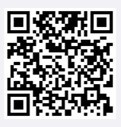Golf and low back pain often are synonymous for some patients. The golf swing is one of the most complicated bio-mechanical athletic activities that can leave some with debilitating back pain. For most the back pain continues at home with pain also hampering their daily routine. But does it have to be this way? The answer is no!
 The golf swing is a complicated movement that involves many moving parts. Reduced motion in just a few areas can greatly increase the stress and load on the low back and hips. A few simple movement screens can test your low back mobility to better understand what is creating your low back pain. These tests are helpful not only for the golfer, but for anyone who is experiencing low back pain with activity.
The golf swing is a complicated movement that involves many moving parts. Reduced motion in just a few areas can greatly increase the stress and load on the low back and hips. A few simple movement screens can test your low back mobility to better understand what is creating your low back pain. These tests are helpful not only for the golfer, but for anyone who is experiencing low back pain with activity.
We created a video demonstrating these three tests. Follow the link with this QR code to our YouTube page or read below for a description of the three tests.
3 Tests for low back mobility:
1. Anterior and Posterior Tilts
The Pelvic Tilt Test is a great test for overall mobility of the hips in the lumbar spine and their ability to control the position of their pelvic posture. The ability to move and control the position of the pelvis is critical for optimal power transfer from the lower body to the upper body during the golf swing.
How to Perform the Pelvic Tilt Test:
Begin by standing in your normal five iron golf set-up with your arms across your chest (hands resting on shoulders). Now tilt the pelvis anteriorly or forward, thus increasing the arch in the lumbar spine. Then tilt the pelvis in the posterior or backward direction flattening the arch in the lower back. Proper execution of this test will yield a forward and backward tilting of the pelvis with minimal leg/knee movement and limited upper body forward and backward movement. The pelvis should move independently of the knees and the upper body.
What to look for in the Pelvic Tilt Test:
Look at how much movement occurs during this test and how smooth it is. If you have a bit of a swayback the movement will be minimal as you arch your hips forward. If you are more flat backed you may notice a lack of posterior tilt. Observe the smoothness or “shake and bake” nature of the movement. This will indicate what frequency those muscles are being used on a day-to-day basis. If there is a lot of shaking with the posterior tilt, you are probably not using those muscles on a regular basis in your golf swing. This will keep your pelvis less stabilized as power is being generated and transferred to the upper extremities. This can lead to a loss of power and accuracy with your golf swing.
2. The Pelvic Rotation Test
The Pelvic Rotation Test checks your ability to rotate the lower body independently from the upper body. This is an important skill for properly sequencing the downswing and to generate a good separation between the upper and lower body. This movement requires good mobility of the spine, hips and pelvis, along with simultaneous stability of the thorax.
 How to Perform the Pelvic Rotation Test:
How to Perform the Pelvic Rotation Test:
Begin again in a normal five-iron posture, with your arms crossed over the shoulders. Feet should be approximately shoulder width apart and your hands should be resting on the front of each shoulder. Once you are in position, do not move the upper body and try to rotate the lower body (belt and below) back and forth in a normal swinging motion. Look for any movement of the shoulders or excessive lateral motion of the pelvis versus rotation.
Just like Chubby Checker, you should be able to twist the pelvis with no shoulder motion. Continue testing in both directions, being sure to monitor the fluidity of motion of the pelvis both in the right and left directions. The fluidity is important in determining golf swing issues.
What to look for with the Pelvic Rotation Test:
Watch for the motion of all body segments above the waistline – including the torso, shoulders, arms, and head/neck region. A proper Pelvic Rotation Test will yield no motion above the waistline with only the pelvis rotating. It is acceptable for the legs and knees to be moving slightly along with the pelvis. However, any excessive knee bending, and straightening should be noted as well.
If you are having difficulty performing this action, try to differentiate between a stability or mobility problem. To test this, have someone hold your upper body stable for you and then try to rotate the pelvis again. If you still can’t separate, you have a mobility problem, if you can separate it is a stability problem.
3. Torso Rotation Test
The Torso Rotation Test checks your ability to rotate the upper body independently from the lower body. This is an important skill for properly sequencing the backswing and generating a good separation or coil. This movement requires good mobility of the thoracic spine, and simultaneous stability of the lower body.
How to Perform the Torso Rotation Test:
Begin by assuming a normal five-iron posture, with your arms crossed over your shoulders. Feet should be approximately shoulder width apart and the hands should be resting on the front of each shoulder. Once you are in position, do not move the lower body but try to rotate the upper body (the torso) back and forth.
What to look for during the Torso Rotation Test:
Look for any movement of the hips or extension and side bend of the thoracic spine versus rotation. Continue testing in both directions being sure to monitor the coordination of motion, as this is important in determining golf swing issues. A proper Torso Rotation Test will yield no motion below the waistline with only the thorax and shoulders rotating.
If you have difficulty performing this action, try to differentiate between a stability or mobility problem. Have someone hold your pelvis stable and then try to rotate your upper body. If you still can’t separate the hips and torso then you have a mobility problem, if you can separate it is a stability problem.
Testing these areas of movement restriction is only the beginning of the road to a pain free golf swing. Working with a competent professional who understands how the body should move, properly assessing the movement restrictions, and being able to remove those restrictions, is key. In our office we use a wide range of treatment options to personally construct the best rehabilitation plan.
For those with acute pain, we may use dry needling as a means to reduce the acute low back pain symptoms. For those that are suffering with a mobility problem we use Active Release Technique to reduce scar tissue and overuse restrictions in the muscles while the chiropractic adjustment is useful for reducing joint restrictions. If the problem is determined to have a stability component, exercises are given. This simple but very effective approach is how we assess movement dysfunctions for the golfer, runner, blue-collar worker, or even the desk jockey. Our goal is to see our patients succeed in a pain free world and help them become healthier than they have ever been.

Daryl C. Rich, D.C., C.S.C.S.








